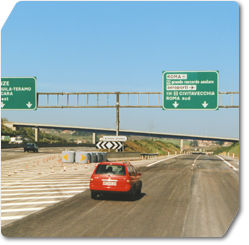- Villa search

- Canaries
- Caribbean
- Croatia, Bulgaria and Hungary
- Cyprus
- Florida
- France and Corsica
- Greece
- Italy
- Lakes and Mountains
- Madeira
- Malta and Gozo
- Portugal
- South Africa
- Spain - Balearics

6 The second challenge is judging the position of your car on the road. Many people driving for the first time in a left hand drive hire car have a tendency to place the car further to the right than they realise. As a result it’s easy, when driving past a line of parked cars, to be a lot closer to them than you think you are, which could lead to a smashed mirror. And you may give your passengers kittens on mountain roads by driving closer to the edge than you realise. So try to leave a good gap to obstacles or traffic on your right, and if in doubt (for instance when meeting other traffic on a narrow road) slow right down or stop.
7 The classic and most dangerous mistake is to drive on the left of the road. This isn’t usually a problem when first setting off (when you are pretty hyped up about getting it right) or in heavy traffic (when the correct side is obvious). No, the problem usually comes after a day or two, when you have relaxed a bit. You pull in for petrol, drive back onto a deserted road, go round the corner and come face to face with a car on your side of the road. Except it’s his side...
It’s nearly always when setting off, or pulling out of a turning, that old habits re-assert themselves. If you think this might be a problem, a visual reminder could help, such as an arrow of white adhesive tape somewhere on the dashboard, pointing to the right. Asking your passengers to shout if they think you’re doing it wrong is also a good idea. Bear in mind, too, that alcohol lowers your alertness, so even a single beer or glass of wine will make you more likely to drive on ‘auto-pilot’.8 The layout of junctions and other road features can be different, perhaps with unfamiliar signs and traffic procedures (especially in America). In one of these road layouts you may suddenly not be sure where you should go. It can be scary, but usually if you take it slowly and don’t panic, all will be well. If in doubt, give way to other traffic, but do bear in mind that too much dithering can itself be dangerous.
9 If you’re visiting America, you will probably end up driving a car with automatic transmission. You may be able to get a small car with manual transmission, but if you need something bigger you will find yourself with an automatic. If, like many British drivers, you have never driven one of these, try to get used to it in this country first. You can hire one for a day or two at reasonable cost. They are easy to drive, but a lot of people do stand the car on its nose once or twice when their left foot instinctively tries to push the non-existent clutch pedal, and finds the enlarged brake pedal instead. The other problem is unintentionally accelerating hard when manoeuvring in a confined space, because you hit the accelerator instead of the brake. Thinking the car has gone mad, you press even harder on the ‘brake’ until the car hits something. A bit of pre-holiday familiarisation could save a lot of hassle.
10 If you’re taking your own car across the Channel, things are easier because you won’t have the problem of driving an unfamiliar car. But you do have the extra drawback of now being on the wrong side of the car to see ahead of the cars in front. This is only really a problem when you need to overtake on a single carriageway road.
You don’t have to be stuck in a queue, afraid to overtake. The answer is to do what you should really do all the time, which is to leave a good gap to the car in front. The further you are from it, the more easily you will see around it – if you’re up close, you won’t see a thing. If you hang well back, you can move towards the middle of the road to get a better view of the road ahead (but don’t hog the centre and infuriate the locals by stopping them getting past you, or making oncoming traffic swerve).
The other important point is to ensure your car is up to the job. A long, hot and fully loaded motorway trip to the south of France can expose the weak points in a car more used to the school run. A full service is the least you should do, and you should consider bringing forward any ‘almost due’ items like a cambelt or brake fluid change before you go. Check whether tyre pressures should be higher for heavy loads and high speeds. For most continental countries you will need to carry a first aid kit, warning triangle and spare bulb kit.
If all this makes driving abroad sound too difficult, don’t be put off. Having a car at your disposal is well-nigh essential for most villa holidays, and can add tremendously to your enjoyment of the holiday.Once you’ve done it successfully, you will wonder what all the fuss was about.
home | destinations and editorial | villa search | property for sale | car hire | flights | services
villaseek blog | contact villaseek | links and resources | advertise your villa© Dune Root Ltd and Villaseek.com 2012 - Caribbean
- Canaries